Gene Expression of Neurogenesis Related to Exercise Intensity in a Cerebral Infarction Rat Model
Abstract
:1. Introduction
2. Results
2.1. Morris Water Maze Test of Neurobehavioral Function
2.2. RNA Sequencing Data
2.3. KEGG Mapper Tool Analysis
2.4. Western Blot Analyses
3. Discussion
4. Materials and Methods
4.1. Experimental Subjects and Ethics Approval
4.2. Methods
4.2.1. Photothrombotic Cerebral Infarction Rat Model
4.2.2. Regular Treadmill Exercise Program
4.2.3. Neurobehavioral Test: The Morris Water Maze
4.2.4. RNA Sequencing Analysis
4.2.5. Western Blot Analysis
4.2.6. Timing of the Experiments
4.2.7. Statistical Analyses
5. Conclusions
Author Contributions
Funding
Institutional Review Board Statement
Data Availability Statement
Conflicts of Interest
References
- El Husseini, N.; Katzan, I.L.; Rost, N.S.; Blake, M.L.; Byun, E.; Pendlebury, S.T.; Aparicio, H.J.; Marquine, M.J.; Gottesman, R.F.; Smith, E.E.; et al. Cognitive Impairment After Ischemic and Hemorrhagic Stroke: A Scientific Statement From the American Heart Association/American Stroke Association. Stroke 2023, 54, e272–e291. [Google Scholar] [CrossRef] [PubMed]
- Lanctot, K.L.; Lindsay, M.P.; Smith, E.E.; Sahlas, D.J.; Foley, N.; Gubitz, G.; Austin, M.; Ball, K.; Bhogal, S.; Blake, T.; et al. Canadian Stroke Best Practice Recommendations: Mood, cognition and fatigue following stroke, 6th edition update 2019. Int. J. Stroke 2020, 15, 668–688. [Google Scholar] [CrossRef]
- MacIntosh, B.J.; Edwards, J.D.; Kang, M.; Cogo-Moreira, H.; Chen, J.L.; Mochizuki, G.; Herrmann, N.; Swardfager, W. Post-stroke fatigue and depressive symptoms are differentially related to mobility and cognitive performance. Front. Aging Neurosci. 2017, 9, 343. [Google Scholar] [CrossRef] [PubMed]
- Oberlin, L.E.; Waiwood, A.M.; Cumming, T.B.; Marsland, A.L.; Bernhardt, J.; Erickson, K.I. Effects of physical activity on poststroke cognitive function a meta-analysis of randomized controlled trials. Stroke 2017, 48, 3093–3100. [Google Scholar] [CrossRef] [PubMed]
- Nelson, E.D.; Maynard, K.R.; Nicholas, K.R.; Tran, M.N.; Divecha, H.R.; Collado-Torres, L.; Hicks, S.C.; Martinowich, K. Activity-regulated gene expression across cell types of the mouse hippocampus. Hippocampus 2023, 33, 1009–1027. [Google Scholar] [CrossRef]
- Svensson, M.; Lexell, J.; Deierborg, T. Effects of Physical Exercise on Neuroinflammation, Neuroplasticity, Neurodegeneration, and Behavior: What We Can Learn From Animal Models in Clinical Settings. Neurorehabil. Neural Repair. 2015, 29, 577–589. [Google Scholar] [CrossRef]
- Inoue, K.; Hanaokam, Y.; Nishijimam, T.; Okamotom, M.; Changm, H.; Saitom, T.; Soyam, H. Long-term mild exercise training enhances hippocampus-dependent memory in rats. Int. J. Sports Med. 2015, 36, 280–285. [Google Scholar] [CrossRef]
- Xiong, J.Y.; Li, S.C.; Sun, Y.X.; Zhang, X.S.; Dong, Z.Z.; Zhong, P.; Sun, X.R. Long-term treadmill exercise improves spatial memory of male APPswe/PS1dE9 mice by regulation of BDNF expression and microglia activation. Biol. Sport 2015, 32, 295–300. [Google Scholar] [CrossRef] [PubMed]
- Cooke, E.V.; Mares, K.; Clark, A.; Tallis, R.C.; Pomeroy, V.M. The effects of increased dose of exercise-based therapies to enhance motor recovery after stroke: A systematic review and meta-analysis. BMC Med. 2010, 8, 60. [Google Scholar] [CrossRef]
- Song, M.K.; Kim, E.J.; Kim, J.K.; Park, H.K.; Lee, S.G. Effect of regular swimming exercise to duration-intensity on neurocognitive function in cerebral infarction rat model. Neurol. Res. 2019, 41, 37–44. [Google Scholar] [CrossRef]
- Ploughman, M.; Granter-Button, S.; Chernenko, G.; Attwood, Z.; Tucker, B.A.; Mearow, K.M.; Corbett, D. Exercise intensity influences the temporal profile of growth factors involved in neuronal plasticity following focal ischemia. Brain Res. 2007, 1150, 207–216. [Google Scholar] [CrossRef] [PubMed]
- Modaberi, S.; Shahbazi, M.; Dehghan, M.; Naghdi, N. The role of mild treadmill exercise on spatial learning and memory and motor activity in animal models of ibotenic acid-induced striatum lesion. Sport. Sci. Health 2018, 14, 587–596. [Google Scholar] [CrossRef]
- Aguiar, A.S.; Castro, A.A.; Moreira, E.L.; Glaser, V.; Santos, A.R.; Tasca, C.I.; Latini, A.; Prediger, R.D. Short bouts of mild-intensity physical exercise improve spatial learning and memory in aging rats: Involvement of hippocampal plasticity via AKT, CREB and BDNF signaling. Mech. Ageing Dev. 2011, 132, 560–567. [Google Scholar] [CrossRef]
- Gegentonglaga; Yoshizato, H.; Higuchi, Y.; Toyota, Y.; Hanai, Y.; Ando, Y.; Yoshimura, A. Variable alteration of regional tissue oxygen pressure in rat hippocampus by acute swimming exercise. Life Sci. 2013, 93, 773–777. [Google Scholar] [CrossRef] [PubMed]
- Ai, J.Y.; Chen, F.T.; Hsieh, S.S.; Kao, S.C.; Chen, A.G.; Hung, T.M.; Chang, Y.K. The effect of acute high-intensity interval training on executive function: A systematic review. Int. J. Environ. Res. Public. Health 2021, 18, 3593. [Google Scholar] [CrossRef]
- Wang, X.Q.; Wang, G.W. Effects of treadmill exercise intensity on spatial working memory and long-term memory in rats. Life Sci. 2016, 149, 96–103. [Google Scholar] [CrossRef] [PubMed]
- Gentleman, R.C.; Carey, V.J.; Bates, D.M.; Bolstad, B.; Dettling, M.; Dudoit, S.; Ellis, B.; Gautier, L.; Ge, Y.; Gentry, J.; et al. Bioconductor: Open software development for computational biology and bioinformatics. Genome Biol. 2004, 5, R80. [Google Scholar] [CrossRef]
- Voss, M.W.; Nagamatsu, L.S.; Liu-Ambrose, T.; Kramer, A.F. Exercise, brain, and cognition across the life span. J Appl Physiol (1985) 2011, 111, 1505–1513. [Google Scholar] [CrossRef] [PubMed]
- Lee, E.; Son, H. Adult hippocampal neurogenesis and related neurotrophic factors. BMB Rep. 2009, 42, 239–244. [Google Scholar] [CrossRef]
- Yamashita, H.; Avraham, S.; Jiang, S.; Dikic, I.; Avraham, H. The Csk homologous kinase associates with TrkA receptors and is involved in neurite outgrowth of PC12 cells. J. Biol. Chem. 1999, 274, 15059–15065. [Google Scholar] [CrossRef]
- Kim, S.O.; Avraham, S.; Jiang, S.; Zagozdzon, R.; Fu, Y.; Avraham, H.K. Differential expression of Csk homologous kinase (CHK) in normal brain and brain tumors. Cancer 2004, 101, 1018–1027. [Google Scholar] [CrossRef] [PubMed]
- Akira, S.; Takeda, K. Toll-like receptor signalling. Nat. Rev. Immunol. 2004, 4, 499–511. [Google Scholar] [CrossRef] [PubMed]
- Rao, N.; Nguyen, S.; Ngo, K.; Fung-Leung, W.P. A novel splice variant of interleukin-1 receptor (IL-1R)-associated kinase 1 plays a negative regulatory role in Toll/IL-1R-induced inflammatory signaling. Mol. Cell Biol. 2005, 25, 6521–6532. [Google Scholar] [CrossRef] [PubMed]
- Feng, D.; Wang, B.; Ma, Y.; Shi, W.; Tao, K.; Zeng, W.; Cai, Q.; Zhang, Z.; Qin, H. The Ras/Raf/Erk Pathway Mediates the Subarachnoid Hemorrhage-Induced Apoptosis of Hippocampal Neurons Through Phosphorylation of p53. Mol. Neurobiol. 2016, 53, 5737–5748. [Google Scholar] [CrossRef] [PubMed]
- Anton, E.S.; Weskamp, G.; Reichardt, L.F.; Matthew, W.D. Nerve growth factor and its low-affinity receptor promote Schwann cell migration. Proc. Natl. Acad. Sci. USA 1994, 91, 2795–2799. [Google Scholar] [CrossRef] [PubMed]
- Meffert, M.K.; Chang, J.M.; Wiltgen, B.J.; Fanselowm, M.S.; Baltimorem, D. NF-kappa B functions in synaptic signaling and behavior. Nat. Neurosci. 2003, 6, 1072–1078. [Google Scholar] [CrossRef] [PubMed]
- Albensim, B.C.; Mattsonm, M.P. Evidence for the involvement of TNF and NF-kappaB in hippocampal synaptic plasticity. Synapse 2000, 35, 151–159. [Google Scholar] [CrossRef]
- Levensonm, J.M.; Choi, S.; Lee, S.Y.; Cao, Y.A.; Ahn, H.J.; Worley, K.C.; Pizzi, M.; Liou, H.C.; Sweatt, J.D. A bioinformatics analysis of memory consolidation reveals involvement of the transcription factor c-rel. J. Neurosci. 2004, 24, 3933–3943. [Google Scholar] [CrossRef]
- Gutierrez, H.; Hale, V.A.; Dolcet, X.; Davies, A. NF-kappaB signalling regulates the growth of neural processes in the developing PNS and CNS. Development 2005, 132, 1713–1726. [Google Scholar] [CrossRef]
- Kaltschmidt, B.; Ndiaye, D.; Korte, M.; Pothion, S.; Arbibe, L.; Prüllage, M.; Pfeiffer, J.; Lindecke, A.; Staiger, V.; Israël, A.; et al. NF-kappaB regulates spatial memory formation and synaptic plasticity through protein kinase A/CREB signaling. Mol. Cell Biol. 2006, 26, 2936–2946. [Google Scholar] [CrossRef]
- Heckscher, E.S.; Fetter, R.D.; Marek, K.W.; Albin, S.D.; Davis, G.W. NF-kappaB, IkappaB, and IRAK control glutamate receptor density at the Drosophila NMJ. Neuron 2007, 55, 859–873. [Google Scholar] [CrossRef] [PubMed]
- Wang, J.; Fu, X.Q.; Lei, W.L.; Wang, T.; Sheng, A.L.; Luo, Z.G. Nuclear factor kappaB controls acetylcholine receptor clustering at the neuromuscular junction. J. Neurosci. 2010, 30, 11104–11113. [Google Scholar] [CrossRef] [PubMed]
- Boersma, M.C.; Dresselhaus, E.C.; De Biase, L.M.; Mihalas, A.B.; Bergles, D.E.; Meffert, M.K. A requirement for nuclear factor-kappaB in developmental and plasticity-associated synaptogenesis. J. Neurosci. 2011, 31, 5414–5425. [Google Scholar] [CrossRef]
- Qiu, J.; Hu, X.; Nesic, O.; Grafe, M.R.; Rassin, D.K.; Wood, T.G.; Perez-Polo, J.R. Effects of NF-kappaB oligonucleotide “decoys” on gene expression in P7 rat hippocampus after hypoxia/ischemia. J. Neurosci. Res. 2004, 77, 108–118. [Google Scholar] [CrossRef] [PubMed]
- Schneider, A.; Martin-Villalba, A.; Weih, F.; Vogel, J.; Wirth, T.; Schwaninger, M. NF-kappaB is activated and promotes cell death in focal cerebral ischemia. Nat. Med. 1999, 5, 554–559. [Google Scholar] [CrossRef]
- Maqbool, A.; Lattke, M.; Wirth, T.; Baumann, B. Sustained, neuron-specific IKK/NF-κB activation generates a selective neuroinflammatory response promoting local neurodegeneration with aging. Mol. Neurodegener. 2013, 8, 40. [Google Scholar] [CrossRef]
- Yu, Z.; Zhou, D.; Bruce-Keller, A.J.; Kindy, M.S.; Mattson, M.P. Lack of the p50 subunit of nuclear factor-kappaB increases the vulnerability of hippocampal neurons to excitotoxic injury. J. Neurosci. 1999, 19, 8856–8865. [Google Scholar] [CrossRef]
- Kaltschmidt, B.; Kaltschmidt, C. NF-KappaB in Long-Term Memory and Structural Plasticity in the Adult Mammalian Brain. Front. Mol. Neurosci. 2015, 8, 69. [Google Scholar] [CrossRef]
- Liu, C.; Liu, S.; Xiong, L.; Zhang, L.; Li, X.; Cao, X.; Xue, J.; Li, L.; Huang, C.; Huang, Z. Genistein-3′-sodium sulfonate Attenuates Neuroinflammation in Stroke Rats by Down-Regulating Microglial M1 Polarization through α7nAChR-NF-κB Signaling Pathway. Int. J. Biol. Sci. 2021, 17, 1088–1100. [Google Scholar] [CrossRef]
- Ye, Y.; Jin, T.; Zhang, X.; Zeng, Z.; Ye, B.; Wang, J.; Zhong, Y.; Xiong, X.; Gu, L. Meisoindigo Protects Against Focal Cerebral Ischemia-Reperfusion Injury by Inhibiting NLRP3 Inflammasome Activation and Regulating Microglia/Macrophage Polarization via TLR4/NF-κB Signaling Pathway. Front. Cell Neurosci. 2019, 13, 553. [Google Scholar] [CrossRef]
- Popa-Wagner, A.; Stöcker, K.; Balseanu, A.T.; Rogalewski, A.; Diederich, K.; Minnerup, J.; Margaritescu, C.; Schäbitz, W.R. Effects of granulocyte-colony stimulating factor after stroke in aged rats. Stroke 2010, 41, 1027–1031. [Google Scholar] [CrossRef] [PubMed]
- Dumbrava, D.A.; Surugiu, R.; Börger, V.; Ruscu, M.; Tertel, T.; Giebel, B.; Hermann, D.M.; Popa-Wagner, A. Mesenchymal stromal cell-derived small extracellular vesicles promote neurological recovery and brain remodeling after distal middle cerebral artery occlusion in aged rats. Geroscience 2022, 44, 293–310. [Google Scholar] [CrossRef] [PubMed]
- Ciobanu, O.; Elena Sandu, R.; Tudor Balseanu, A.; Zavaleanu, A.; Gresita, A.; Petcu, E.B.; Uzoni, A.; Popa-Wagner, A. Caloric restriction stabilizes body weight and accelerates behavioral recovery in aged rats after focal ischemia. Aging Cell 2017, 16, 1394–1403. [Google Scholar] [CrossRef]
- Zhang, Y.; Yu, J.; Lee, C.; Xu, B.; Sartor, M.A.; Koenig, R.J. Genomic binding and regulation of gene expression by the thyroid carcinoma-associated PAX8-PPARG fusion protein. Oncotarget 2015, 6, 40418–40432. [Google Scholar] [CrossRef]
- Koch, C.M.; Chiu, S.F.; Akbarpour, M.; Bharat, A.; Ridge, K.M.; Bartom, E.T.; Winter, D.R. A Beginner’s Guide to Analysis of RNA Sequencing Data. Am. J. Respir. Cell Mol. Biol. 2018, 59, 145–157. [Google Scholar] [CrossRef] [PubMed]
- Blondeau, A.; Lucier, J.F.; Matteau, D.; Dumont, L.; Rodrigue, S.; Jacques, P.É.; Blouin, R. Dual leucine zipper kinase regulates expression of axon guidance genes in mouse neuronal cells. Neural Dev. 2016, 11, 13. [Google Scholar] [CrossRef]
- Watson, B.D.; Dietrich, W.D.; Busto, R.; Wachtel, M.S.; Ginsberg, M.D. Induction of reproducible brain infarction by photochemically initiated thrombosis. Ann. Neurol. 1985, 17, 497–504. [Google Scholar] [CrossRef] [PubMed]
- Bedford, T.G.; Tipton, C.M.; Wilson, N.C.; Oppliger, R.A.; Gisolfi, C.V. Maximum oxygen consumption of rats and its changes with various experimental procedures. J. Appl. Physiol. Respir. Environ. Exerc. Physiol. 1979, 47, 1278–1283. [Google Scholar] [CrossRef]
- Morris, R.G.; Garrud, P.; Rawlins, J.N.; O’Keefe, J. Place navigation impaired in rats with hippocampal lesions. Nature 1982, 297, 681–683. [Google Scholar] [CrossRef]
- Kim, H.J.; Hur, S.W.; Park, J.B.; Seo, J.; Shin, J.J.; Kim, S.Y.; Kim, M.H.; Han, D.H.; Park, J.W.; Park, J.M.; et al. Histone demethylase PHF2 activates CREB and promotes memory consolidation. EMBO Rep. 2019, 20, e45907. [Google Scholar] [CrossRef]
- Langmead, B.; Salzberg, S.L. Fast gapped-read alignment with Bowtie 2. Nat. Methods 2012, 9, 357–359. [Google Scholar] [CrossRef] [PubMed]
- Quinlan, A.R.; Hall, I.M. BEDTools: A flexible suite of utilities for comparing genomic features. Bioinformatics 2010, 26, 841–842. [Google Scholar] [CrossRef] [PubMed]
- Duffau, H. Brain plasticity and reorganization before, during, and after glioma resection. In Glioblastoma; Elsevier: Amsterdam, The Netherlands, 2016; pp. 225–236. [Google Scholar]
- Kanehisa, M.; Sato, Y.; Kawashima, M. KEGG mapping tools for uncovering hidden features in biological data. Protein Sci. 2022, 31, 47–53. [Google Scholar] [CrossRef] [PubMed]
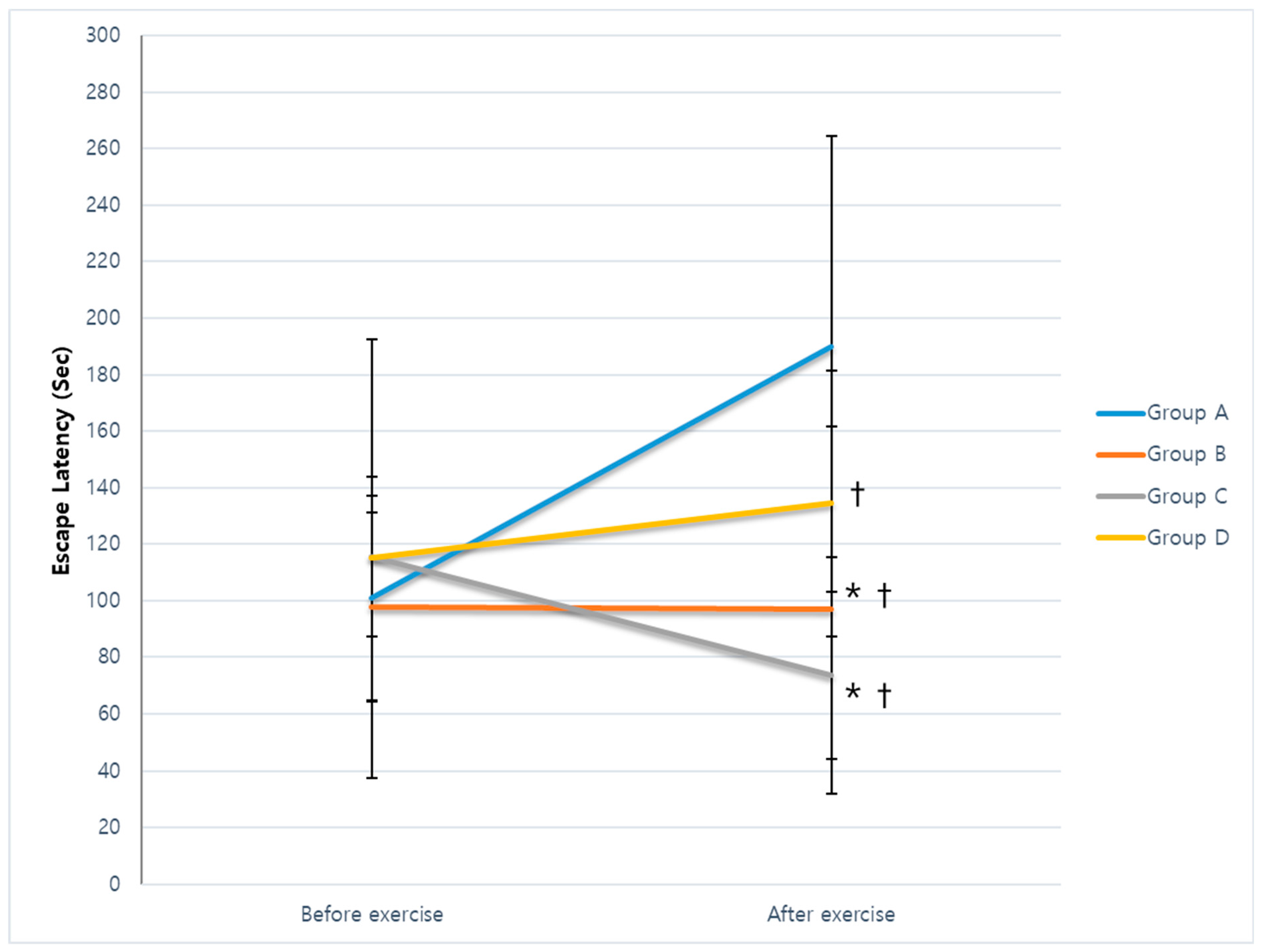
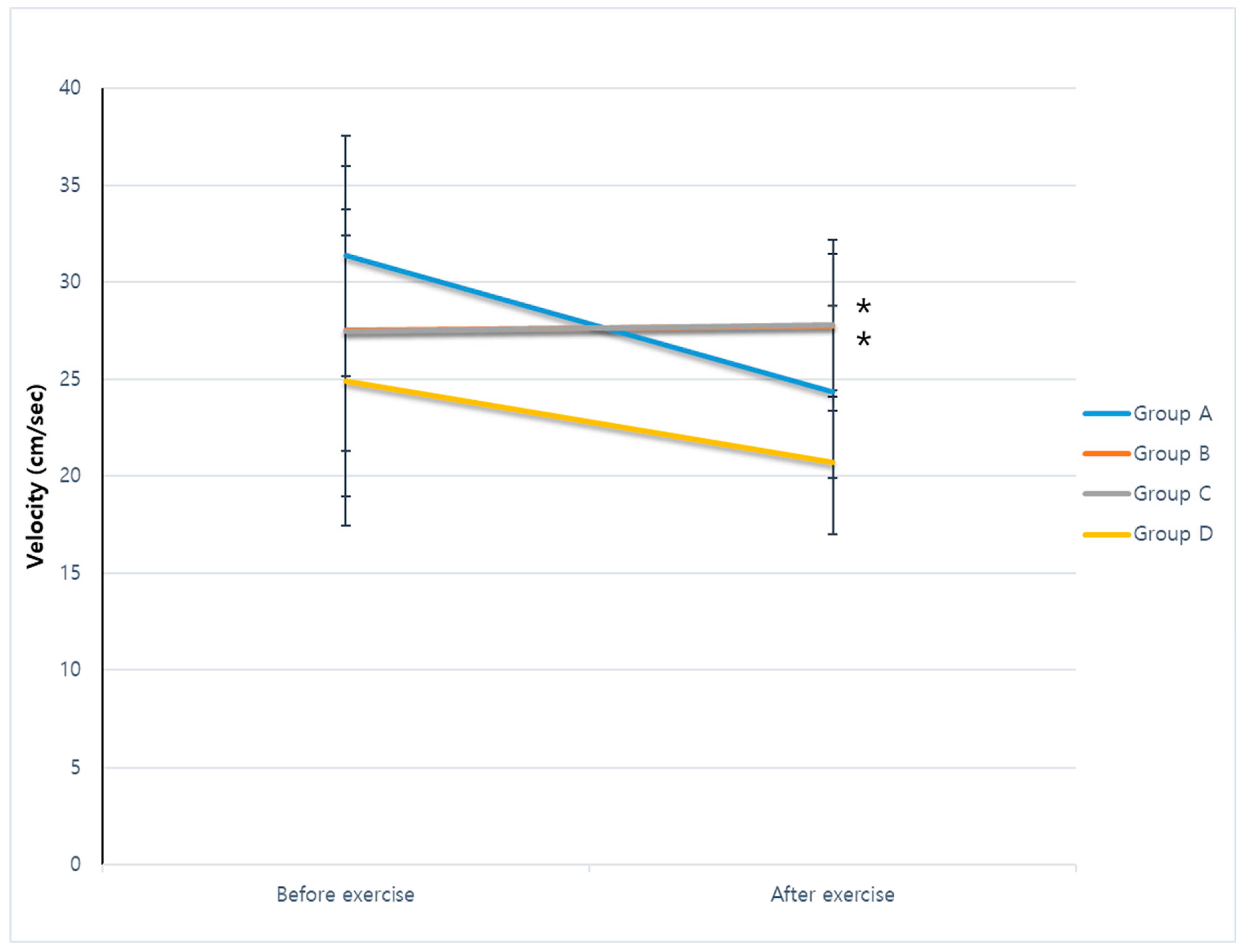

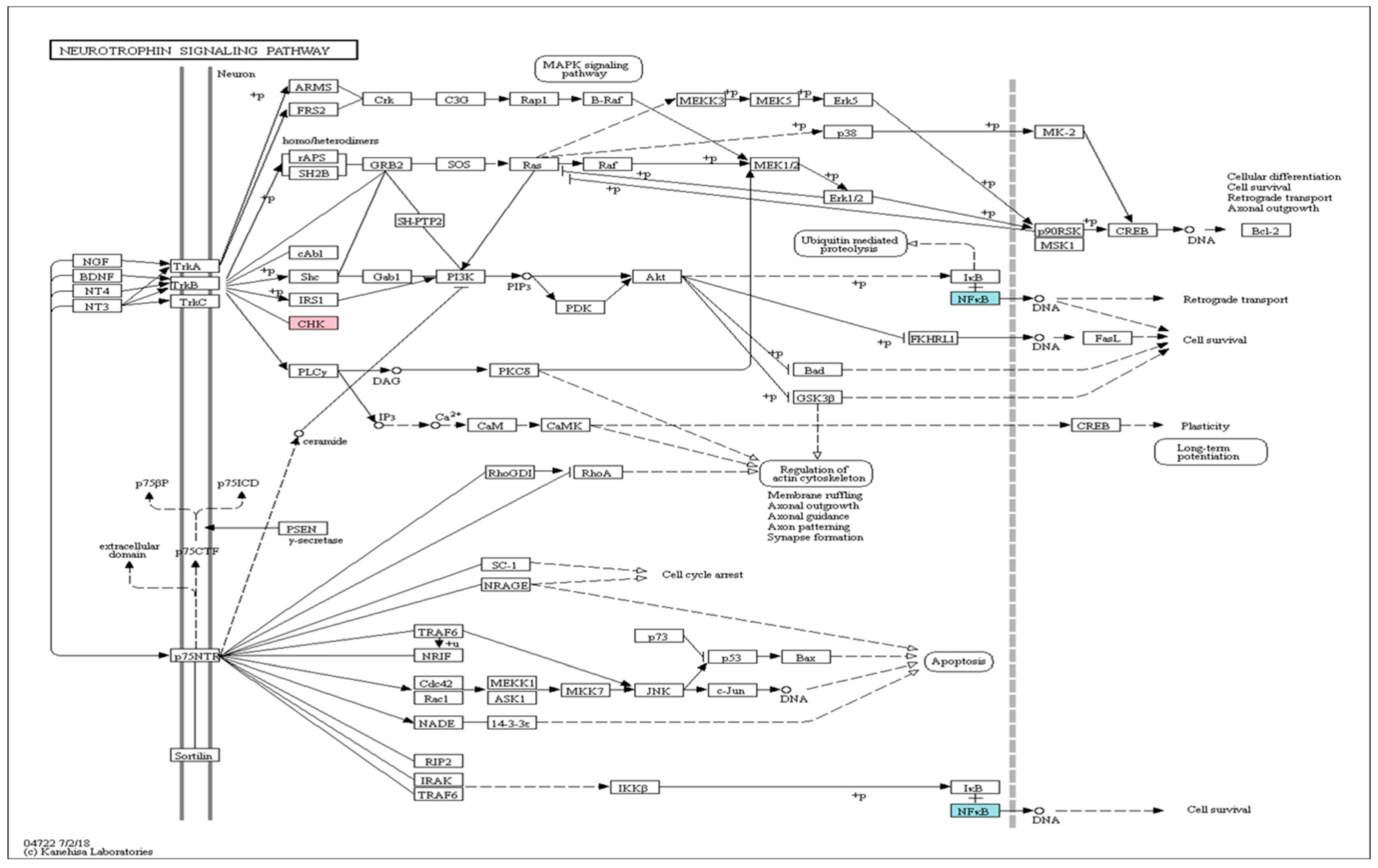

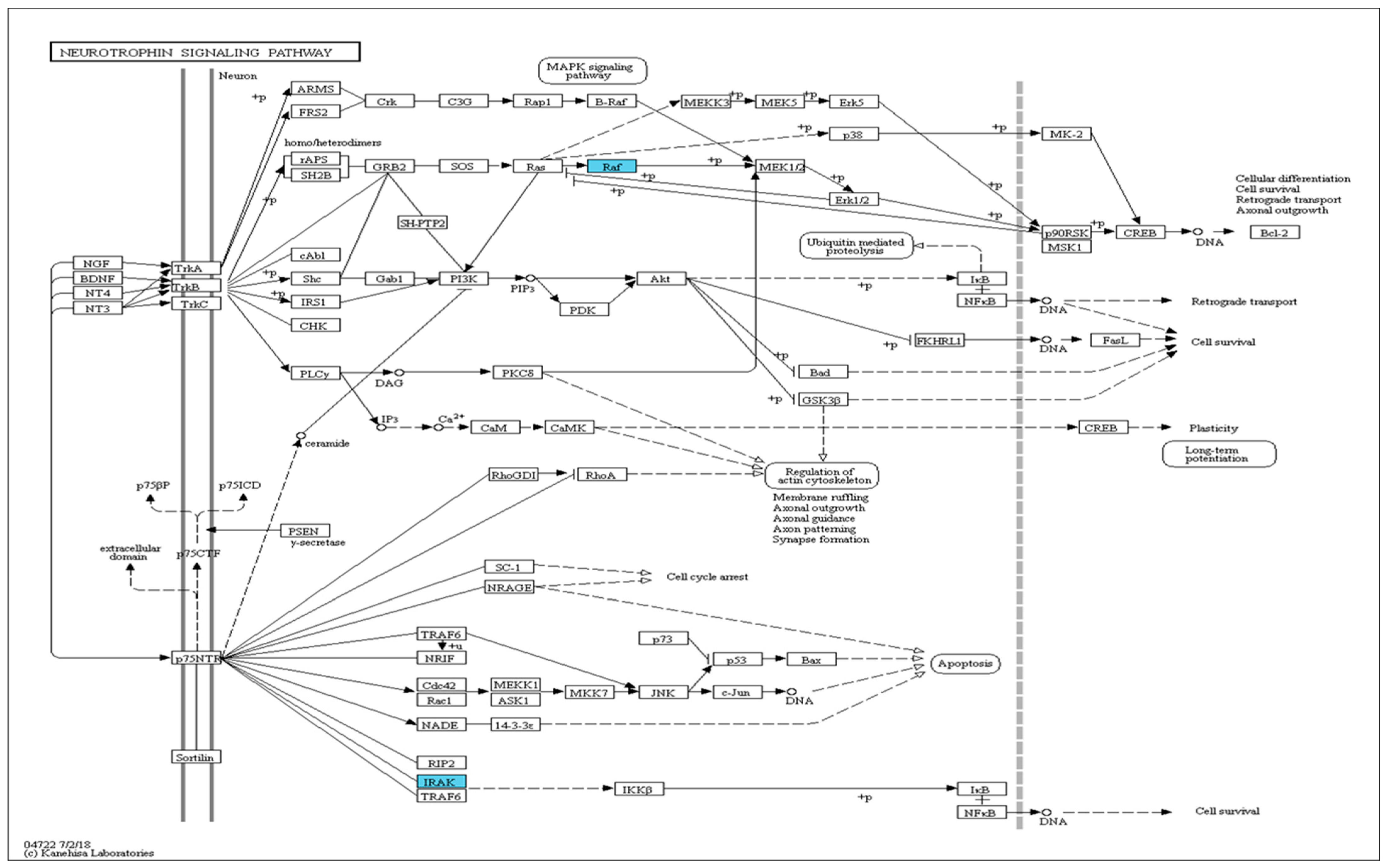

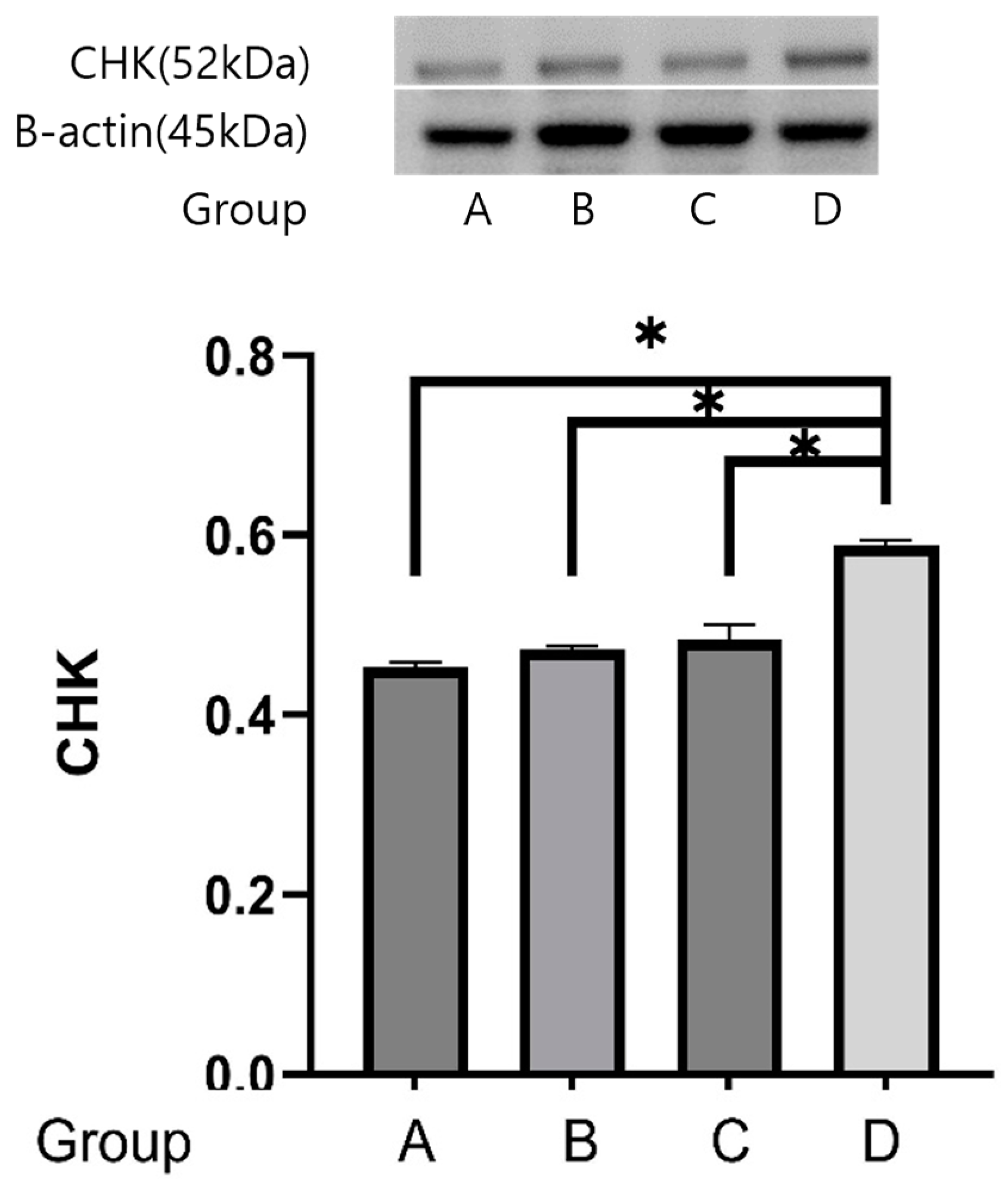



Disclaimer/Publisher’s Note: The statements, opinions and data contained in all publications are solely those of the individual author(s) and contributor(s) and not of MDPI and/or the editor(s). MDPI and/or the editor(s) disclaim responsibility for any injury to people or property resulting from any ideas, methods, instructions or products referred to in the content. |
© 2024 by the authors. Licensee MDPI, Basel, Switzerland. This article is an open access article distributed under the terms and conditions of the Creative Commons Attribution (CC BY) license (https://creativecommons.org/licenses/by/4.0/).
Share and Cite
Song, M.-K.; Jo, H.-S.; Kim, E.-J.; Kim, J.-K.; Lee, S.-G. Gene Expression of Neurogenesis Related to Exercise Intensity in a Cerebral Infarction Rat Model. Int. J. Mol. Sci. 2024, 25, 8997. https://doi.org/10.3390/ijms25168997
Song M-K, Jo H-S, Kim E-J, Kim J-K, Lee S-G. Gene Expression of Neurogenesis Related to Exercise Intensity in a Cerebral Infarction Rat Model. International Journal of Molecular Sciences. 2024; 25(16):8997. https://doi.org/10.3390/ijms25168997
Chicago/Turabian StyleSong, Min-Keun, Hyun-Seok Jo, Eun-Jong Kim, Jung-Kook Kim, and Sam-Gyu Lee. 2024. "Gene Expression of Neurogenesis Related to Exercise Intensity in a Cerebral Infarction Rat Model" International Journal of Molecular Sciences 25, no. 16: 8997. https://doi.org/10.3390/ijms25168997
APA StyleSong, M.-K., Jo, H.-S., Kim, E.-J., Kim, J.-K., & Lee, S.-G. (2024). Gene Expression of Neurogenesis Related to Exercise Intensity in a Cerebral Infarction Rat Model. International Journal of Molecular Sciences, 25(16), 8997. https://doi.org/10.3390/ijms25168997





